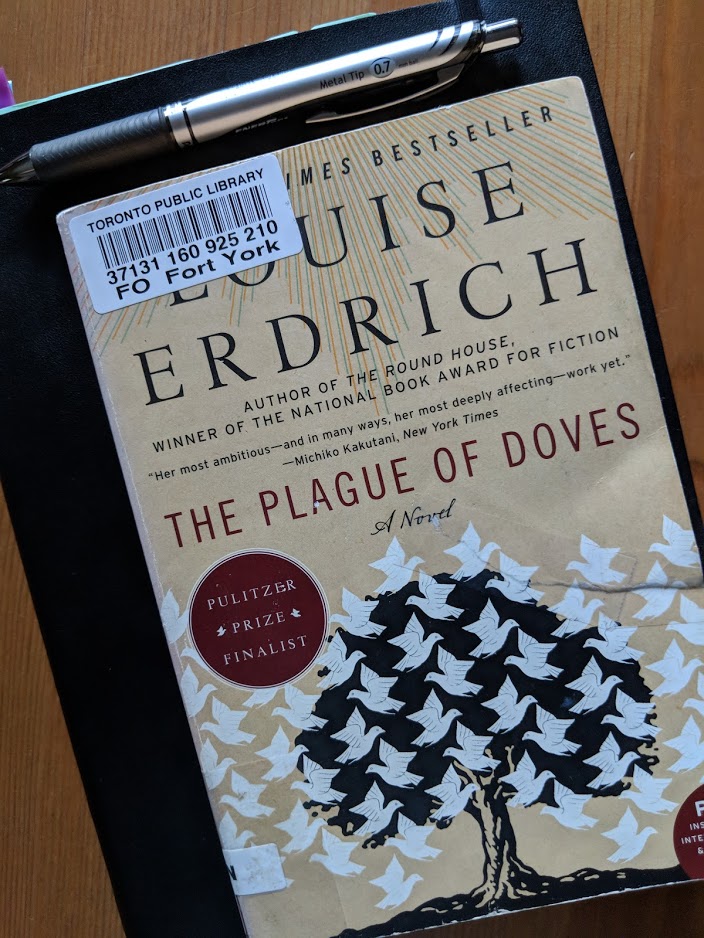Talk of The Painted Drum (2005), The Plague of Doves (2008) and Shadow Tag (2010) in under 300 words each, with an eye to finishing a project.
The Painted Drum is one of Erdrich’s accessible novels (I also recommend The Last Miracles at Little No Horse and The Master Butchers Singing Club.)
Her rapid interplay of time lines and characters’ voices is present in a simple form here, with only two main lines and no long historical sections until later in the novel with a couple of present-day characters to cling to while you get your bearings.
At the heart of the story is the eponymous drum, which actually exists and also works symbolically to link the present-day with the past, the heartbeat of survival in the face of so many challenges.

There are a lot of layers to the narrative which consider the urgency of art and creativity, a vocational drive, whether through story or music or sculpture or beading. As much as is possible alongside the work of endurance and perseverance. “Only when you are secure enough not to fear immediate survival can you display creative intelligence in anything you do.”
And, as with so many of Erdrich’s novels, there is an intense love relationship simmering beneath.
““Did you love him?”
“Of course.” She is looking down at her hands. “Inordinately, foolishly,” she whispers, then looks up at me. “But that is the way people should be loved.”

With a poet’s eye, Erdrich does not clutter her prose with imagery in The Plague of Doves. She places images into scenes so that colours and shapes bring a place to life for readers, but she also takes care to allow them to display another layer of meaning.
“Mooshum finished talking as the storm moved over us – the clouds low and black-bellied. In the yard, the sheets were thrashing wild, the overalls and Mooshum’s work shirts were ballooning out. Even my mother’s pastel underthings were flying straight back, wisps, and her bras corkscrewed around the wooden pins and line.”
Here, as a storm approaches, it seems to be linked with a man’s power (rooted in his age and his position in the family and community) and readers feel that intensity but simultaneously notice the feminine fragments spiralling and flitting in the turmoil. (Normally her mother keeps her fragments concealed, drying beneath other items.)
Some of the women in Erdrich’s novels have intense and satisfying relationships with men, deep and lasting; there are also men in these novels who do harm, whether an incident or a pattern, and one girl’s observations embody a wariness which she has absorbed from the experiences of women.
“I was looking at them [men] just to figure, for pure survival, the way a girl does. It is like a farmer, which my dad is, gets to know the lay of the land. He loves his land so he has got to figure how to cultivate it. What it needs in each season, how much abuse it will sustain, what in the end it will yield to him.”
A slimmer novel than the rest, Shadow Tag features a character who has spent her married life assessing and evaluating with her survival in mind. Here, too, the power of words and paint, the resonance of politically charged images and purposefully shaped stories.
“A soul could be captured through a shadow. It was in the Ojibwe language. Waabaamoojichaagwaan – the word for mirror also can refer to shadow and to the soul: your soul is visible and can be seen. Gil had placed his foot on Irene’s shadow when he painted her. And though she tried to pull away, it ws impossible to tug that skein of darkness from under his heel.”
Gil’s paintings are impressive and successful. Irene’s figure as an Indian woman in the work is her and not-her; in some ways the paintings chronicle the history of the couple’s relationship and, in other ways, she does not really exist on the canvas. There are also three children in the marriage with Irene and Gil and, through these characters, readers experience a different kind of sense of dislocation as the children struggle to see themselves reflected in the world around them.
“Indians wore powwow clothes all of the time and could talk to animals. Riel had to wonder why she couldn’t do any of these things. Maybe she could train herself. It could come in very handy to be an Indian, after all.”
There aren’t any Indians like that in Louise Erdrich’s fiction, which is what makes her stories so powerful: character-driven and constantly searching for a way to reflect life’s endless interconnections, in our selves and in our relationships.

With only two more Erdrich novels on my list for 2018, I can see my two-year project wrapping up as planned in December. (I still plan to read LaRose and The Future Home of the Living God this year, and the rest of her Little Frog children’s series next year, with some other children’s series I would also like to finish.)
LOUISE ERDRICH PROJECT
The Painted Drum (2005)
The Plague of Doves (2008)
Shadow Tag (2010)
LaRose (2016)

Say something bookish, or just say 'hey'